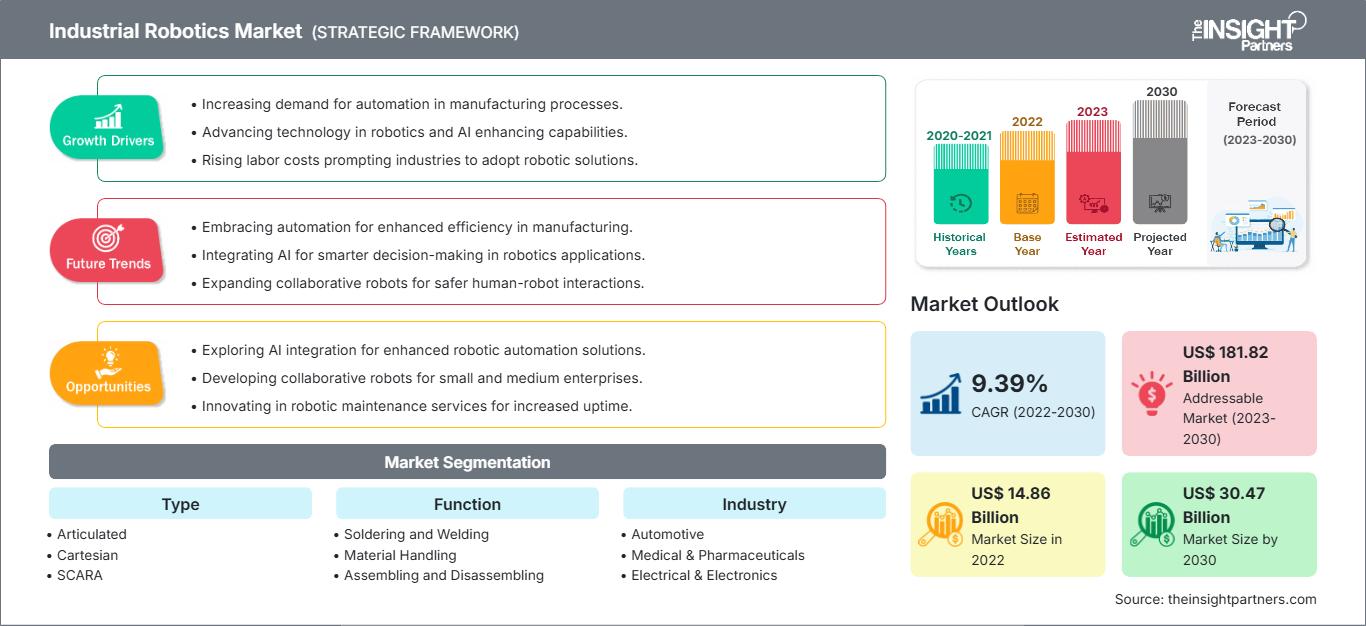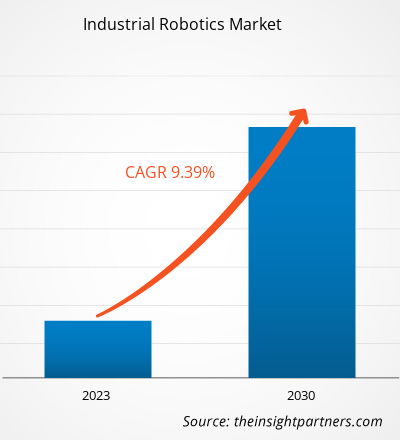산업용 로봇 시장 규모는 2022년 148억 6천만 달러에서 2030년에는 304억 7천만 달러로 성장할 것으로 예상됩니다. 2022년부터 2030년까지 연평균 성장률 9.39%를 기록할 것으로 예상됩니다. 5G 기술과 엣지 컴퓨팅에 대한 수요 증가는 시장의 주요 트렌드로 남을 것으로 예상됩니다.
산업용 로봇 시장 분석
산업 4.0 개념의 발전과 운영 효율성 향상을 위한 협동 로봇에 대한 수요 증가가 시장을 주도하고 있습니다. 제조, 창고 및 물류 산업의 자동화 수요 증가로 인해 예측 기간 동안 시장이 성장할 것으로 예상됩니다. 또한, 로봇 공학에 인공지능 기술이 통합됨에 따라 수익성 있는 시장 기회가 창출되고 있습니다.
산업용 로봇 시장 개요
산업용 로봇은 센서와 제어 장치가 장착된 로봇 팔로 정의할 수 있으며, 이를 통해 산업용 제품 생산 과정에서 다양한 기능과 작업을 수행할 수 있습니다. 로봇은 반복적인 작업을 주기적으로 수행하도록 프로그래밍되어 있습니다. 이 로봇은 생산 과정에서 인적 요소를 대폭 줄이는 동시에 처리 속도, 품질, 그리고 생산 능력을 향상시킵니다. 로봇의 가장 중요한 구성 요소는 관절과 연결부로 구성된 팔입니다. 팔 끝 도구(EOAT)는 로봇 팔에서 가장 중요한 구성 요소입니다. EOAT는 마킹, 절단, 용접, 드릴링, 도장, 청소 등 다양한 작업을 수행합니다.이 보고서의 일부, 국가 수준 분석, Excel 데이터 팩을 포함하여 모든 보고서에 대한 사용자 정의를 무료로 받을 수 있을 뿐만 아니라 스타트업 및 대학을 위한 훌륭한 제안 및 할인을 이용할 수 있습니다
산업용 로봇 시장: 전략적 통찰력

-
이 보고서의 주요 주요 시장 동향을 확인하세요.이 무료 샘플에는 시장 동향부터 추정 및 예측에 이르기까지 데이터 분석이 포함됩니다.
인더스트리 4.0은 혁신적인 유지보수 전략, 특히 실시간 데이터 분석과 머신러닝을 기반으로 하는 예측 및 상태 기반 유지보수 전략을 강화합니다. 이러한 접근 방식은 계획되지 않은 가동 중단 시간을 최소화하고 자산 활용도를 최적화하며 유지보수 비용을 절감하여 상당한 운영 효율성을 제공합니다. 이러한 발전은 자동차, 전자, 물류, 제약 등 다양한 산업 분야에서 로봇 도입을 가속화할 것으로 예상됩니다. 이전에는 수작업으로 이루어졌던 노동 집약적인 작업을 자동화할 수 있게 되면 생산성이 향상될 뿐만 아니라 인력 부족 및 임금 상승과 같은 과제도 해결할 수 있습니다.
더 나아가, 스마트 로봇 시스템의 도입은 기계 관리 및 생산 가시성을 향상시켜 기업이 수요 변동 및 생산 이상에 더욱 신속하게 대응할 수 있도록 지원합니다. 제조업체들이 디지털 혁신에 지속적으로 투자함에 따라 향후 몇 년 동안 지능형 로봇 솔루션에 대한 수요가 크게 증가할 것으로 예상됩니다. 연결성, AI, 자동화의 힘을 활용함으로써 기업은 점점 더 디지털화되는 경제에서 더욱 민첩하고 효율적이며 경쟁력을 확보할 수 있습니다. 따라서 인더스트리 4.0의 발전은 산업 환경에서 로봇의 역할을 재정의하고 있으며, 이는 결국 산업용 로봇 시장을 활성화하고 있습니다.
로봇 공학에 인공지능 기술 통합
AI는 로봇 공학 및 자동화 분야에서 괄목할 만한 발전을 이끌고 있습니다. 로봇 공학 분야의 AI가 발전하고 발전함에 따라, 수많은 산업에서 이러한 최첨단 기술을 활용하고 있습니다. 정교한 데이터 수집 및 분석을 위한 지능적 자동화 프로세스 구현, 기업, 서비스 기업 및 제조업체의 데이터 기반 의사 결정 지원, 자가 학습 로봇 구현을 통한 업무 프로세스 및 작업 지원 등이 그 예입니다. AI 기반 자가 학습 로봇의 도입은 예측 기간 동안 시장에서 기회를 창출할 것으로 예상됩니다.산업용 로봇 시장 보고서 세분화 분석
산업용 로봇 시장 분석 도출에 기여한 주요 부문은 유형, 기능 및 산업입니다.- 산업용 로봇 시장은 유형에 따라 다관절, 직교, 스카라, 협업, 병렬 및 기타로 구분됩니다. 다관절 부문은 2022년에 가장 큰 시장 점유율을 차지했습니다.
- 기능별로 시장은 납땜 및 용접, 자재 취급, 조립 및 분해, 도장 및 분배, 밀링, 절단 및 가공으로 구분됩니다. 자재 취급 부문은 2022년에 가장 큰 시장 점유율을 차지했습니다.
- 산업 측면에서 시장은 자동차, 의료 및 제약, 전기 및 전자, 고무 및 플라스틱, 금속 및 기계, 식품 및 농업으로 구분됩니다. 식품 및 2022년에는 농업 부문이 가장 큰 시장 점유율을 기록했습니다.
지역별 산업용 로봇 시장 점유율 분석
산업용 로봇 시장 보고서의 지리적 범위는 주로 북미, 아시아 태평양, 유럽, 중동 및 아프리카, 중남미의 5개 지역으로 나뉩니다.산업용 로봇 수요 증가로 인해 유럽 시장은 예측 기간 동안 확대될 것으로 예상됩니다. 산업용 로봇 설치는 2020년 대비 2021년에 33% 증가했습니다. 2021년 산업용 로봇 사용량은 전자 산업에서 22%, 자동차 산업에서 57%, 금속 및 기계 산업에서 29% 증가했습니다. IFR에 따르면 2023년 1월 기준 중국, 일본, 한국은 연간 산업용 로봇 설치량 기준 상위 5개국에 속했으며, 중국의 산업용 로봇 시장이 가장 높은 성장을 경험했습니다.
산업용 로봇 시장 지역별 통찰력
The Insight Partners의 분석가들은 예측 기간 동안 산업용 로봇 시장에 영향을 미치는 지역별 동향과 요인들을 면밀히 분석했습니다. 이 섹션에서는 북미, 유럽, 아시아 태평양, 중동 및 아프리카, 그리고 중남미 지역의 산업용 로봇 시장 세분화 및 지역별 분포도 살펴봅니다.
산업용 로봇 시장 보고서 범위
| 보고서 속성 | 세부 |
|---|---|
| 시장 규모 2022 | US$ 14.86 Billion |
| 시장규모별 2030 | US$ 30.47 Billion |
| 글로벌 CAGR (2022 - 2030) | 9.39% |
| 이전 데이터 | 2020-2021 |
| 예측 기간 | 2023-2030 |
| 다루는 세그먼트 |
By 유형
|
| 포함된 지역 및 국가 |
북미
|
| 시장 선도 기업 및 주요 회사 프로필 |
|
산업용 로봇 시장 참여자 밀도: 비즈니스 역학에 미치는 영향 이해
산업용 로봇 시장은 소비자 선호도 변화, 기술 발전, 그리고 제품의 이점에 대한 인식 제고 등의 요인으로 인한 최종 사용자 수요 증가에 힘입어 빠르게 성장하고 있습니다. 수요가 증가함에 따라 기업들은 제품 라인업을 확장하고, 소비자 니즈를 충족하기 위한 혁신을 추진하며, 새로운 트렌드를 적극 활용하고 있으며, 이는 시장 성장을 더욱 가속화하고 있습니다.

- 을 얻으세요 산업용 로봇 시장 주요 주요 플레이어 개요
- ABB Ltd는 미시간주 오번힐스에 있는 기존 로봇 본사 및 생산 공장 확장 공사를 시작함으로써 가장 중요한 고객 시장 중 하나인 미국에 대한 투자를 재확인했습니다. 이 프로젝트는 2023년 11월까지 완료될 예정이며, 2천만 달러의 비용이 소요될 것으로 예상됩니다. 이 확장은 미시간 사업 개발 프로그램(Michigan Business Development Program)의 성과 기반 보조금 45만 달러를 통해 해당 지역에 72개의 새로운 고숙련 일자리를 창출할 것입니다. (출처: ABB Ltd, 회사 웹사이트, 2023년 3월)
산업용 로봇 시장 보고서 범위 및 성과물
"산업용 로봇 시장 규모 및 예측(2020~2030년)" 보고서는 다음 영역을 포괄하는 시장에 대한 자세한 분석을 제공합니다.- 범위에 포함된 모든 주요 시장 부문에 대한 글로벌, 지역 및 국가 수준의 산업용 로봇 시장 규모 및 예측
- 산업용 로봇 시장 동향 및 동인, 제약 및 주요 기회와 같은 시장 역학
- 자세한 PEST/포터의 5가지 힘 및 SWOT 분석
- 주요 시장 동향, 글로벌 및 지역 프레임워크, 주요 업체, 규정 및 최근 시장 개발을 포괄하는 산업용 로봇 시장 분석
- 시장 집중도, 히트맵 분석, 주요 업체 및 산업용 로봇 시장의 최근 개발을 포괄하는 산업 환경 및 경쟁 분석
- 자세한 회사 프로필
- 과거 분석(2년), 기준 연도, CAGR을 포함한 예측(7년)
- PEST 및 SWOT 분석
- 시장 규모 가치/거래량 - 글로벌, 지역, 국가
- 산업 및 경쟁 환경
- Excel 데이터세트
최근 보고서
사용 후기
구매 이유
- 정보에 기반한 의사 결정
- 시장 역학 이해
- 경쟁 분석
- 고객 인사이트
- 시장 예측
- 위험 완화
- 전략 기획
- 투자 타당성 분석
- 신흥 시장 파악
- 마케팅 전략 강화
- 운영 효율성 향상
- 규제 동향에 발맞춰 대응






















 무료 샘플 받기 - 산업용 로봇 시장
무료 샘플 받기 - 산업용 로봇 시장